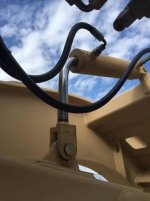Henro
Super Member
- Joined
- Jul 4, 2003
- Messages
- 5,004
- Location
- Few miles north of Pgh, PA
- Tractor
- Kubota B2910, BX2200, KX41-2V mini EX
Hi,
I must admit that I went back and tried to read this thread a second time, in its entirety, as the conclusion reached at the end does not compute in my mind: I mean I don't know what the conclusion is !
The placement of a cylinder to give better routing of hoses is not where my confusion is. Neither is the consideration of having the rod seal on the bottom where dirt would fall off rather than accumulate.
Was the question related to cylinder extension and retraction forces settled?
It seems like there was denial that a cylinder could provide more force in one direction than the other. In the end was this "fact" accepted or not?
Granted a cylinder will extend regardless whether fluid is pumped in on the rod end of the piston, or the cylinder-bore side of the piston, if the other side of the cylinder is left open to atmosphere, or returned to tank. But the force generated by the cylinder will be greater if the fluid is pumped into the cylinder-bore side of the piston.
At the end of the day, was the conclusion that as long as the fluid is pumped into the cylinder bore side of the cylinder, the force generated will be the same (maximum for that cylinder) regardless of cylinder orientation? I think this must be it... Pumping fluid into the bore end of the cylinder would give maximum extension force, and maximum loader lift.
If this is the case then cylinder orientation would be chosen according to best hydraulic line routing and rod seal considerations.
Hope I hit the nail on the head!
Bill
I must admit that I went back and tried to read this thread a second time, in its entirety, as the conclusion reached at the end does not compute in my mind: I mean I don't know what the conclusion is !
The placement of a cylinder to give better routing of hoses is not where my confusion is. Neither is the consideration of having the rod seal on the bottom where dirt would fall off rather than accumulate.
Was the question related to cylinder extension and retraction forces settled?
It seems like there was denial that a cylinder could provide more force in one direction than the other. In the end was this "fact" accepted or not?
Granted a cylinder will extend regardless whether fluid is pumped in on the rod end of the piston, or the cylinder-bore side of the piston, if the other side of the cylinder is left open to atmosphere, or returned to tank. But the force generated by the cylinder will be greater if the fluid is pumped into the cylinder-bore side of the piston.
At the end of the day, was the conclusion that as long as the fluid is pumped into the cylinder bore side of the cylinder, the force generated will be the same (maximum for that cylinder) regardless of cylinder orientation? I think this must be it... Pumping fluid into the bore end of the cylinder would give maximum extension force, and maximum loader lift.
If this is the case then cylinder orientation would be chosen according to best hydraulic line routing and rod seal considerations.
Hope I hit the nail on the head!
Bill


